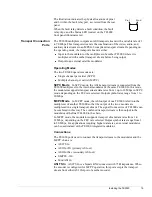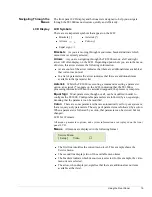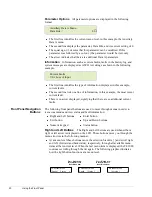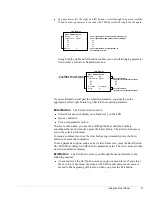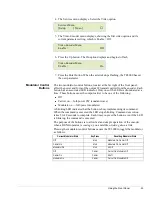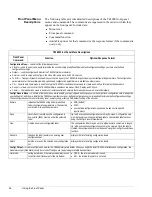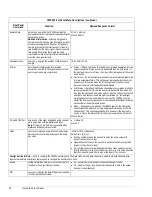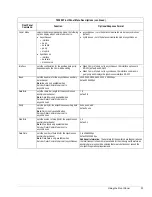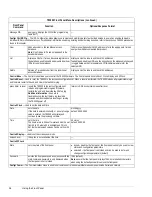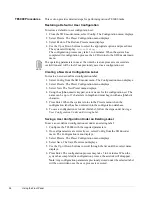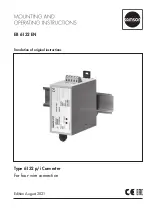
26
Using the Front Panel
Front Panel Menu
Descriptions
The following table provides detailed descriptions of the TE3000 front panel
menus and commands. The commands are organized in the order in which they
appear on the front panel. Included are:
!
Menu level
!
Front panel command
!
Command function
!
Available options for that command or the response format if the command is
query-only
TE3000 Front Panel Menu Descriptions
Front Panel
Command
Function
Options/Response Format
Configuration Menu — consists of the following submenus:
!
Presets — used to quickly and easily re-initialize the encoder using predefined factory default configuration settings your own user-defined
configuration settings
!
Output — used to configure and monitor the TE3000 internal modulator
!
Service — used to setup and configure the video, VBI, audio, data, and PCR services
!
Tx Strm — Transport Stream menu enables you to set and query the TE3000 transport stream system configuration parameters. The configuration
parameters set at this level impact which options and configuration parameters are available on other menus.
!
CA — Conditional Access menu is used to setup the TE3000 for conditional access and to create and modify a list of authorized decoders
!
Control — allows you to control the TE3000 hardware; submenus are Reset, Clock, Display, and FP Lock.
!
Comm — Communications menu is used to set remote control and network features; submenus are Serial and Network.
Config>Presets Menu — Consists of four submenus, which enable you to quickly and easily save your own user-defined configuration sets, manage the
user-defined list, and then re-initialize the TE3000 using either your user-defined configuration sets or predefined factory default configuration settings.
These configuration sets are not altered by reset, power cycling, or factory DVB default setting of the encoder.
Restore
initializes the TE3000 using either predefined
factory configuration parameters or the selected
user-stored, site-specific parameters
!
DVB (default)
!
ATSC
!
user-defined configurations, as needed, based on site-specific
requirements
Save
saves the current site-specific configuration in
non-volatile (flash) memory under the selected
label
Up to 99 user-defined configuration sets may be saved. Configuration sets
must be saved to existing user-defined labels. User-defined labels are set
using the Config>Presets>New feature.
New
creates a new user configuration label
The configuration label may be up to 15 alpha-numeric characters in length.
Up to 99 user-defined configuration sets may be created. Once the label is
created, the configuration set must be saved using the Config>Presets>Save
function.
Rename
changes the label (name) of an existing user
configuration set
displays the list of existing configuration labels
Delete
deletes, or erases, the selected user configuration
set
displays the list of existing configuration labels
Config>Output — Used to configure and monitor the TE3000 internal modulator. When you begin the initial TE3000 installation and configuration, the
modulator output (Mod State) should be turned off until you are ready to begin satellite transmissions.
Out Mode
setting determines if the internal modulator is used
to control the bit rate output of the multiplexer
!
QPSK – the internal modulator is used
!
ASI – the internal modulator is not used
Summary of Contents for TE3000
Page 10: ...viii Preface ...
Page 14: ...4 TE3000 Overview ...
Page 52: ...42 Using the Front Panel ...
Page 94: ...84 Maintenance and Software Upgrades ...
Page 96: ...86 Technical Specifications ...
Page 102: ...92 TE3000 PID Assignments ...
Page 112: ...102 Glossary ...




